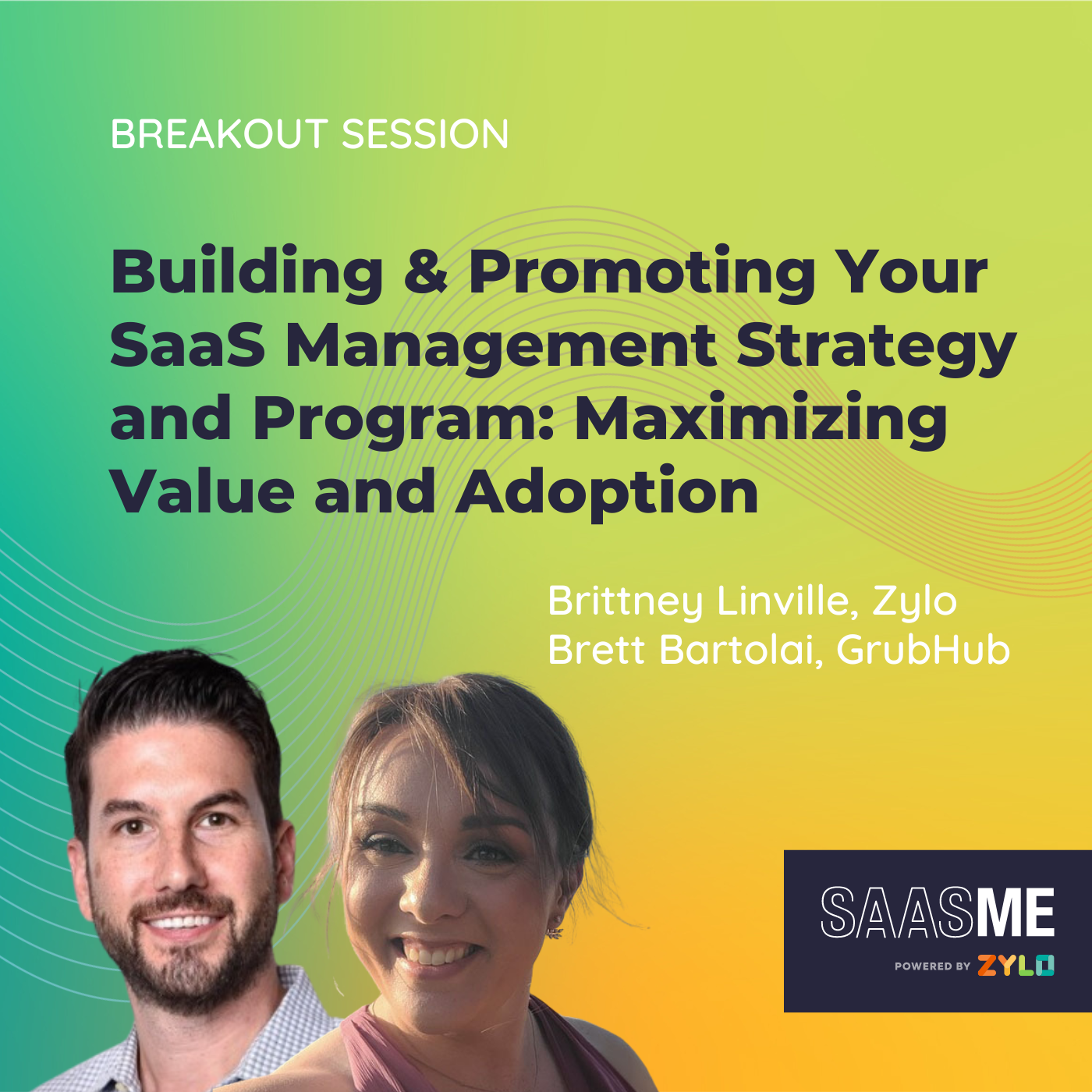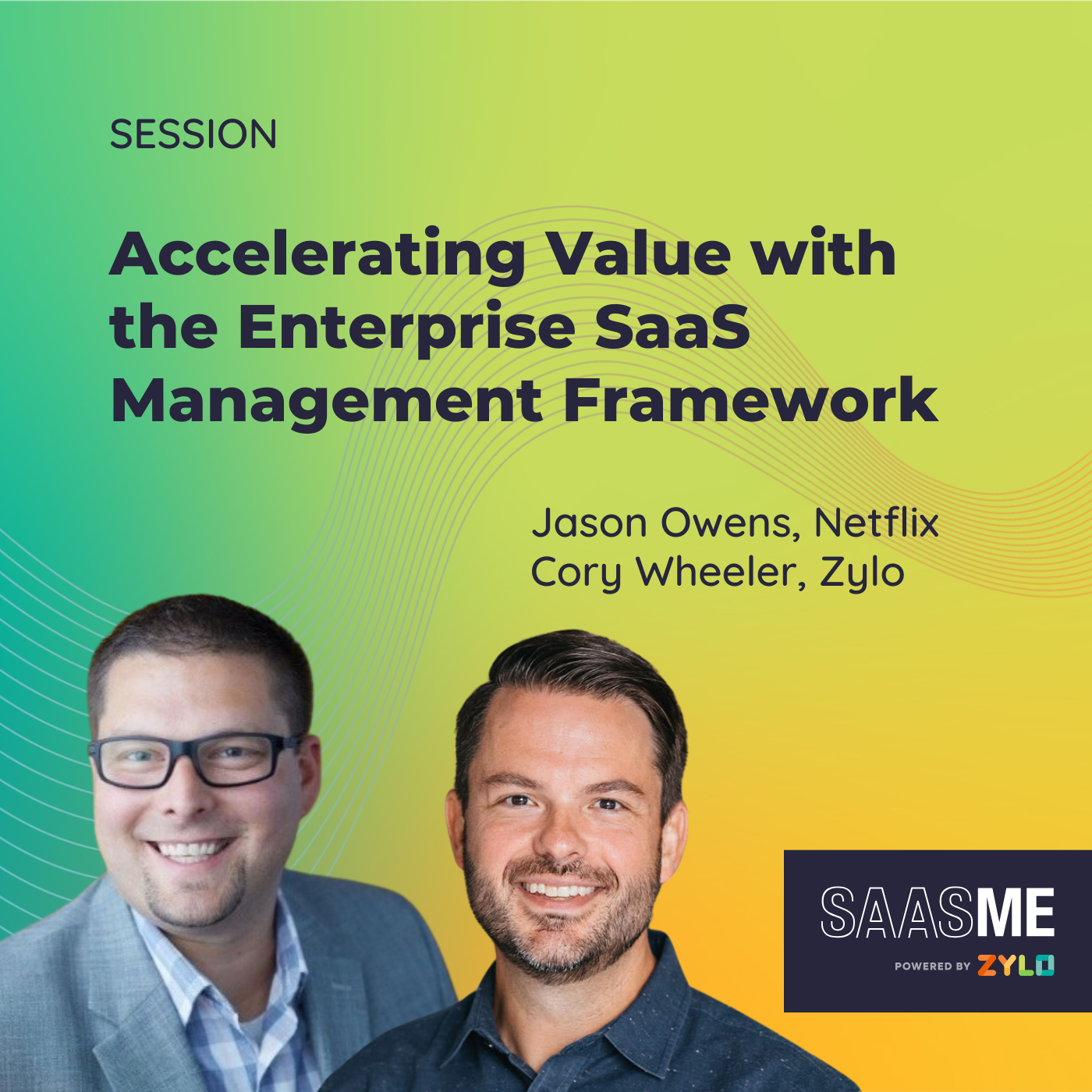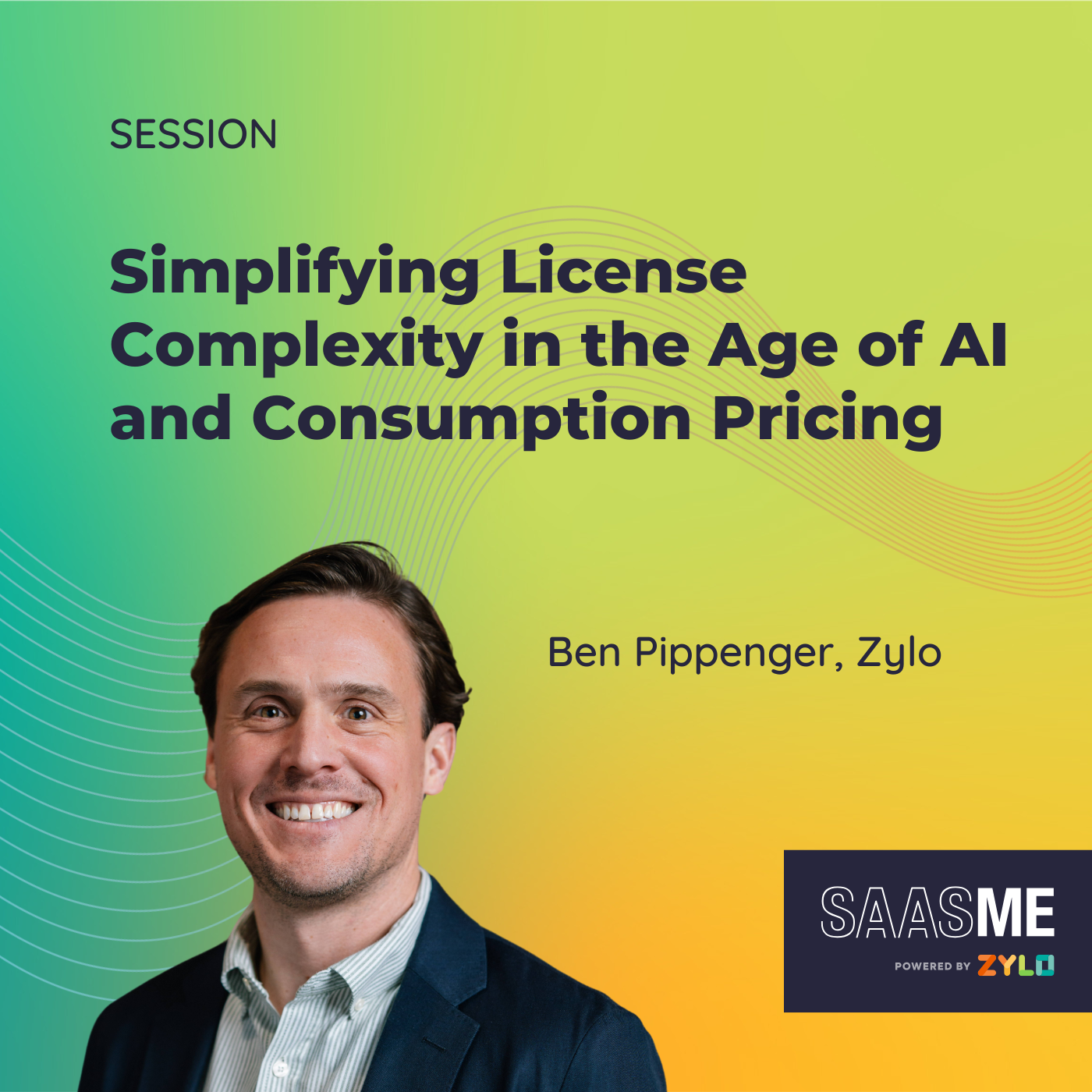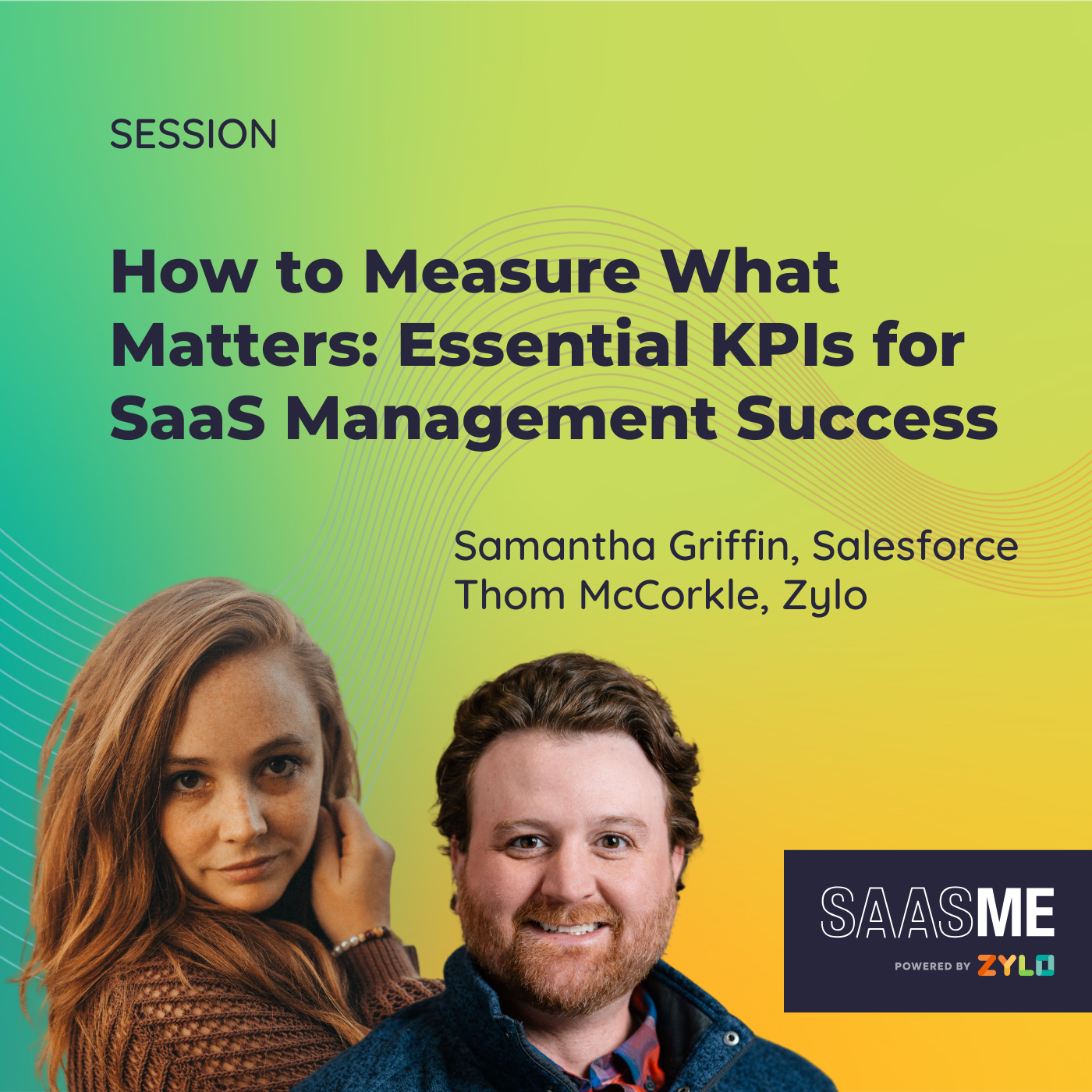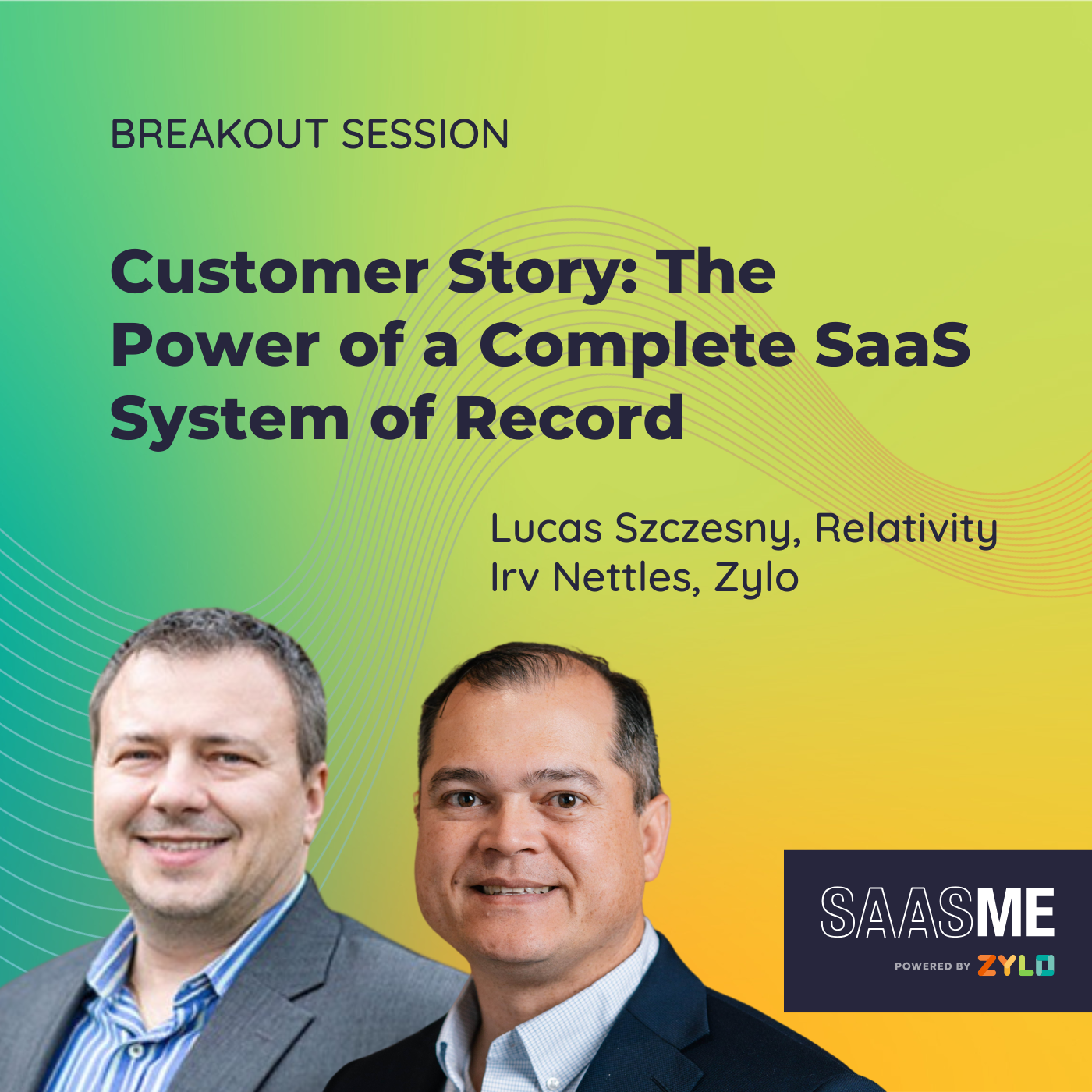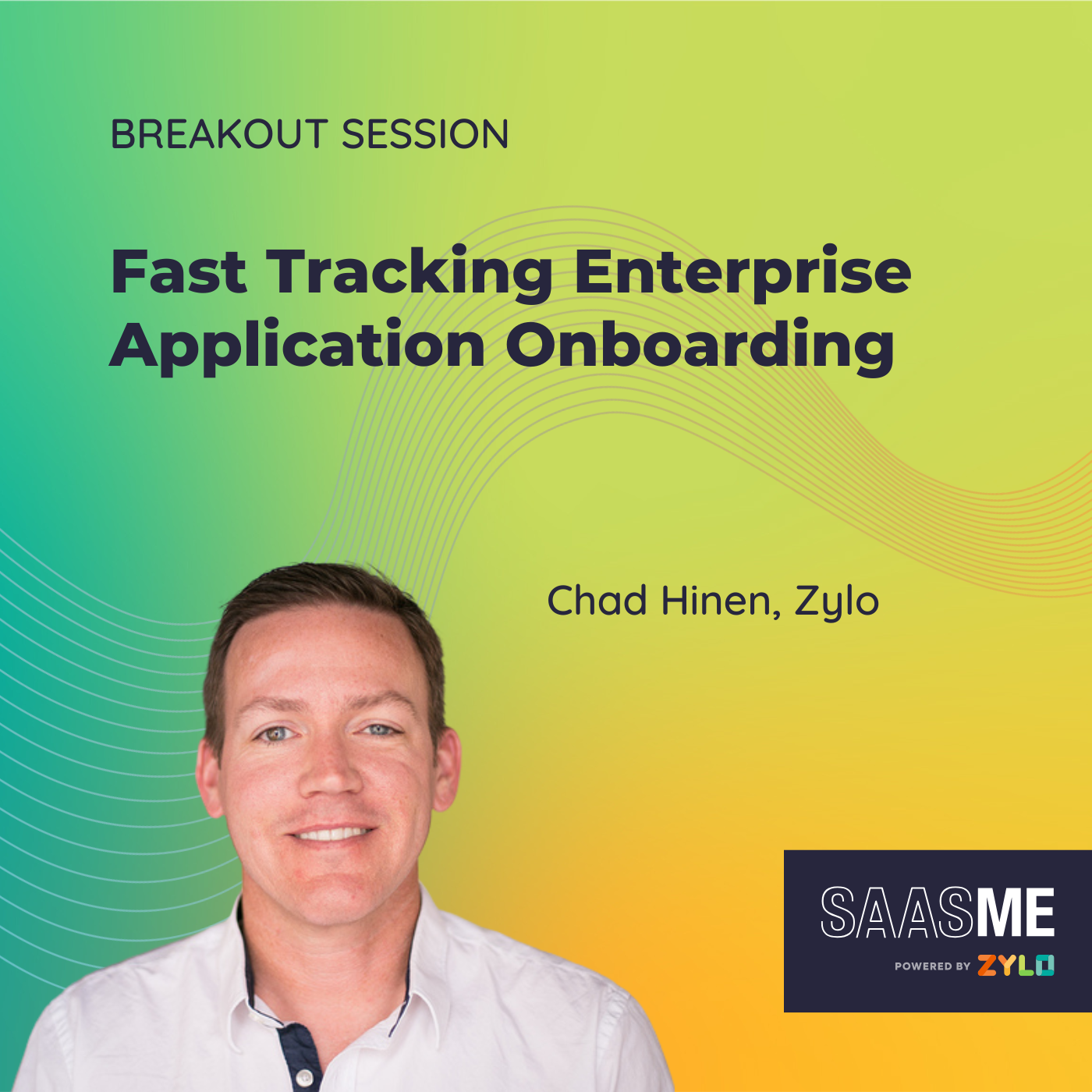Building & Promoting Your SaaS Management Strategy and Program: Maximizing Value and Adoption
- 0.5
- 1
- 1.25
- 1.5
- 1.75
- 2
Brittney Linville: Hi everyone. Thank you for joining us for SaaSMe. We're really happy to have you here. My name is Brittney Linville and I'm a strategic account axecutive here at Zylo. And today I'm joined by Brett Bartolai and we're going to be having a chat about how to build out a SaaS management strategy and program within your organization, and also getting support from other people, including executives in order to help make that program successful. So a little bit of my background, I'm a former customer of Zylo, where I've previously led procurement programs and built them out at high- growth SaaS companies. Brett, I'd love you to introduce yourself.
Brett Bartolai: Hey, really happy to be here. Brett Bartolai, head of North America procurement for Grubhub and SkipTheDishes. I've been with Grubhub close to seven years now.
Brittney Linville: Awesome. Well, I would love to chat with you because we both have a unique experience of having built out SaaS programs at different organizations. So I'd love to talk about some keys to success that you've seen as you've been building out those programs. There was one really interesting podcast that you did recently with Zylo where you said it takes five or six stakeholder groups to make a SaaS management program work. When you're looking to build out a program and for those that are viewing this session as well, who are those stakeholders that you knew to go get input from?
Brett Bartolai: We found that to be one of the primary keys to success is bring in as many stakeholder groups as you can and as makes sense. So for us at Grubhub, those stakeholder groups were not only procurement of course, but FP& A, corporate IT, cybersecurity, engineering, and legal. Those six all provide us with very, very valuable input on a daily and weekly basis for our SaaS program.
Brittney Linville: And I found a lot of those similar groups as well. And one of the challenges I think that I discovered early on is sometimes these groups have conflicting goals and conflicting priorities. And so have you experienced that? And what are some ways that you worked through bringing these teams together that may not normally engage with one another?
Brett Bartolai: So that's going to happen from time to time and we solve that or at least try to solve it in a couple of different ways. One, we have multiple checkpoints every week with the stakeholders. So every Tuesday we meet with the corporate IT and cybersecurity teams to go through our pipeline. And every Thursday we meet with FP& A and some other components to discuss more with the budgeting aspects of what folks want to buy within Grubhub. So we've got multiple communication pipelines for groups to bring things up. And then a few of the areas where we see perhaps some conflicting priorities is A, on process. So one stakeholder may want to adjust the process that more suits them in their working style or their decision- making approval flow. And then another situation is when you just simply have to expedite a contract in, you need to move as quickly as possible. So in those situations there's likely no easy answers and that's why we have to work together. And the most important piece of that I feel is ensuring that you make your stakeholders feel heard and that you want to seek a solution that fits their needs. You try to find a compromise that doesn't get in the way of the overall business goals, but of course that's not always possible. But having those conversations and ensuring that you're understanding what they're seeking out is super important. And then when you do get to times where you cannot support the request, it's very helpful to have one owner, one person that's driving it, that's empowered to make some decisions at an investment.
Brittney Linville: I totally agree, and I think one of the things that was successful for me, like you said, is those meetings that keep you engaged with those stakeholders on an ongoing basis. I live my life by analogies because it helps make those complex things seem less complex. And one of the things that I've often said about procurement is that you're not just building the house and then turning the keys over to someone who's going to enjoy living in this beautiful new home. You're also the one that's got to then do the maintenance on that house. So when something breaks or something's not working very well, you're the one that's showing up to come in and get things back on track. So it is something that building a procurement program, there's no end to it. You're constantly going to be involved in improving it over time. And having those meetings, having those regular check- ins with people, you mentioned doing yours on Wednesdays, we did ours on Monday. Grab a cup of coffee, let's prep for the week and see how it's going to go. So collaborating across those departments and boundaries was super important for us and something that helped lead to our success. I also remember over time those meetings and bringing people together, it helped build that credibility with other teams as well. So then we started being involved in other processes that historically we weren't involved with. That when the FP&A teams were meeting with their application and budget owners, now we started coming into the loop as procurement so that we could plan their growth for different applications as they were budgeting in future fiscal years as well. And then I often found that for us when we were building these programs, when we were starting to bring these teams together, there's this common saying that data is always greater than an opinion. So when you can back something up with data that's often going to allow you to make decisions and move forward more quickly. And for me, data was the foot in the door when you're building a program. But we all know that different teams have different tools that they love, things that may not be utilized very highly, but teams love them. They are married to them, they want to keep them. But then you come in and you're like, " Hey, but this is only 10% utilized." I guess what data points have you found successful when you're working with teams to try to get them on board with these programs and get on board with, " Hey, maybe we don't need that application."
Brett Bartolai: I think it's important to go as deep as possible into the data, within reason. I think there's of course the basic information such as login and when did specific individuals log in last. And if they didn't log in within 90 days, you can pull the license. That's probably the easiest data point to monitor and track. But in my experience, that doesn't necessarily tell the deeper story. So then maybe going the next level deeper, what type of license do folks have and how are they using it? You could have license site that's view- only which is more of the executor tiers and editable tiers, et cetera. So how many of the view- onlys do you have versus the executor tiers and licenses? And see if there's any adjustments you can make between those and try to really determine who needs to actually do work and who only actually needs to view the work that's being done. That could be the next level. And then potentially you go even a level deeper if you're an organization that does this, track back to the business case and say, " All right, what was this tool originally supposed to solve?" And there should be some sort of ROI attached to it. And without providing specific examples, you should be able to get into the data in whatever type of software tool it is that drives back to an ROI. What is the actual output of somebody logging into the SaaS software and what does the outcome of somebody using the tool bring for the company? And so if you can get to that level of detail, then typically you're able to understand that this is a tool that's worth keeping.
Brittney Linville: For me there's a lot of data points that you can pull from, but it's about bringing value when you bring those stakeholders in. So I often found within Zylo there were a few different pieces of information that would matter to an engineering leader versus a budget owner. So my engineering leaders, they wanted to go out and purchase new tools. They wanted to be innovative and expand the way that our products worked with our customers. So once I got them involved, they were really heavily looking at utilization of their applications and they started their own little internal competition for who can find the most savings. So it was really interesting to see the way that they leverage data versus the finance team was more looking at, " How are we tracking budget to actual on this? When we set a budget for this application for the year, are we overspending it? Do we end up buying more licenses?" That data really helped them make good decisions. And along with that, I don't know if you saw this on the Grubhub side, but we saw it where I was at where COVID had this explosion of tools. We wanted people to be able to work effectively remotely. But then as people were returning to work, we started to realize we purchased a lot of tools that were really underutilized. A great example of this was one team had purchased a lot of learning and development tools for people to grow their career. But then those tools ended up being very expensive, but low utilization. So the finance team wanted to cut those tools and pivot to learning stipends. But the learning and development tool is like, " No, this is a really great recruiting thing that we want to put out there and show people what we do." It was only really through analyzing the data of utilization that that came together to say, " Hey, people find more benefit in tools that are relating to their careers versus us picking a tool for them." And so that's how we were able to leverage that data and drive those decisions.
Brett Bartolai: I mean, absolutely. We saw a lot of that too in the L& D example resonates where you want to be able to offer your employees a nice suite of self- service learning tools that will help them drive their career in. And as part of that, there can be compromises within that where maybe you don't have to buy a license for every single employee within the company. But you have a certain set of licenses and it's more use it or lose it. Or perhaps request a license, use it for a period of time and then give it back. So within that specific example, I think there are ways to continue to support the L& D's recruiting goals without having to overspend on items where we may not be getting the best ROI.
Brittney Linville: Exactly. We talked a bit about leveraging that data to bring people in and all the great groups that you can involve. But there's also challenges in building out these programs. Building procurement in an organization, bringing people together, it's not easy. It's not always smooth sailing as much as we'd like it to be. And so there's often programs can go off track or cause friction when they're being stood up. I know one of the things that I've seen that could cause friction to standing up a procurement organization and standing up procurement at a company is when you have different things where there's initiatives that get put in play, but maybe it's difficult to actually implement. And one of the things that I saw at a prior organization was savings mandates that weren't backed by data, where there was a savings target of 20% across the board on all renewals. But that didn't factor in things like when you renew, or the pricing structure with the vendor, or if there was going to be growth that was going to happen. In one case, we were doubling our licenses, but there was this 20% savings mandate. And so for me, I pivoted back to actually using data to show the real savings that we had and those opportunities that we had at renewal, talked about the potential cost avoidance versus those net savings. So hey, we can reclaim these unused licenses to stay below our par value. But we can't actually drop real actual costs until our renewal happens in two years because we'd originally signed a multi- year deal. And so sharing that example to an executive team at the time helped them realize the true potential of savings and guide it through those savings goals. And so once they got that update backed by data, they wanted more data, more frequently, more dashboards, and then it became my responsibility to surface those relevant data points to them. And so with that, it's like once you have good data and people realize like, " Oh, Brittney's got a bunch of dashboards. She's got a bunch of great information." You become the source of truth for all of those questions. So how do you surface data to leaders that you're trying to make decisions on your SaaS stack?
Brett Bartolai: I mean it can be in many, many structures. And for me, I think the key is to ensure you know who your audience is. So I report out to our CFO on how we are tracking on software on a quarterly basis. And we went through a big initiative last year too. To what you were saying, Brittney, post- COVID, we got a bit inflated and how can we pair that back? And so at the CFO level, it's how many new requests are we getting? How many SaaS software did we terminate? How many did we downsize? How many actually increased because of CPI that we weren't able to negotiate to net neutral? So a number of different actions across that. And that was the information we provided to our CFO. To get to that level, we had to have functional leader discussions, and that was a certain level of information. And that included supplier span contract, expiration use case, understanding what their budget was. In trying to implement a forecast to say, " Okay, this software is actually driven by the number of people we have, or this software is driven by the number of orders Grubhub has." So trying to give them some information on what the cost levers are, to have a valuable discussion on what's important, what's not, and where the costs are expected to go in 2024. And then you get down to the next level down, which is the folks that are responsible for executing either on A, maintaining the tools. Or B, trying to be as efficient as possible in the optimization portion of things. And hopefully they're more interested in the weeds. And that gets into some of the data points that we discussed previously is, " Okay, what types of licenses or what types of uses do we have? And are there ways to be creative within that?" So at any level, however though I think it's important that the key is to be consistent in helping folks understand the level of information we have and then be consistent in how we're sharing it across the functional groups so everybody knows our approach to using the data, and that will help inform our steps that we take from there.
Brittney Linville: I think for me it was leveraging data to evangelize the program to others as well. And whether it's through you and I have talked about dashboards and how it just visualizes that data really well. But there was one time where our finance team was like, " Nope, we're not budgeting growth into your application. So if you guys want something new, you got to find savings somewhere." I mentioned earlier, once I have the data for executives, they're like, " Well, hey, can you give visibility to the team? The team wants to go find some savings." And I was like, " Okay, because I've been trying to get them to find savings for a really long time in these applications." And so I put them in there and set up some views in Zylo and just let them start looking at the information themselves. And really, I mentioned it was the team coming in with a competition of like, " Hey, I found some savings over here. Can we buy this new thing now?" And it became something that got evangelized across the organization because they had motivation to find savings as well. And once they got in there and started looking at it, it actually made my job in procurement a lot easier because we would get to a renewal. They would come to me like, " No, no, Brittney, we can cut those licenses in half." Or, " Oh no, we don't need that app anymore. We want to save money so we can reallocate that somewhere else." And it was only through getting them in there and getting them access to it that they really started utilizing the data as well.
Brett Bartolai: I think what you're saying is actually something that is useful in the sense of, I was speaking to somebody this week and that person told me it doesn't matter who's doing great procurement as long as great procurement happens. The point of that statement was the procurement team at times maybe we want to be the ones that own the process or drive the action so that we can" own the value and savings that comes with that." But to your point, Brittney, you're sharing the value and you're sharing the ability for others to get into Zylo and see things for themselves and take action for themselves. And that's also great procurement, and it doesn't just have to be driven by us. It's more give them the tools and give them a philosophy, and maybe the cultural spread around that.
Brittney Linville: And as we wrap things up together, there's one thing that I always loved when I was a customer and coming to SaaSMe. And so I want to pass that forward to the other people who are listening to this session. What is a piece of advice that you can pass forward to others that you've received when you've been building procurement and managing SaaS at Grubhub that you can pass forward that may help other people that are standing up programs or standing up SaaS management?
Brett Bartolai: So I think there's something my boss said to me early on in my time here at Grubhub. And one version of it is don't trust anybody. A nicer version of it is, maybe don't take people's word for it. And what I mean by that is a lot of people have a lot of great intentions, especially when it comes to software. It doesn't mean that people are doing anything malicious or they're trying to be bad actors within an organization. But software and tools can be very, very exciting, and people's eyes can get very big when they see a software that can help them do their jobs. What I think a lot of people fail to fully recognize is that when you're implementing software, there's a lot of work that goes into it. Software without the right process and the right people and the right focus can get wasteful very quickly. That just happens. And so part of my job is to not just take people's word for it, that the software is going to solve everybody's problems and they're going to implement it within the timeframe they say they are, and they're not going to get their priorities shifted to other things. We try to really question ahead of signing a contract and making a commitment for at least a year that we have all the appropriate stakeholder support from the top down to ensure that this tool is going to be used and there's going to be the right level of action and focus to it. I would say make sure you're doing that and don't take people's word for it and go through your own due diligence to make sure that this is valuable for the company.
Brittney Linville: I appreciate that. That's definitely something. Question things and make sure that you're getting the right information and putting the right plans in place. I think one of the best pieces of advice that I got was don't let perfection be the enemy of teamwork. And oftentimes, I wouldn't want to get other people involved because I wanted the data to be perfect. I wanted everyone to have this perfect clear picture of all the things before I would let them in and I would let them see it. But I often found that by sharing with others, they can help me perfect the data where I may not know it or may not have the information readily available. So by bringing them in and letting them know, " I have this information, but I'm missing this information," it just helped us grow it out together. So hopefully those of you that are listening to this session, there's little nuggets that you can take from this. But we want to thank you Brett for taking your time with us today, and we want to thank all of you who tuned into this session. We really appreciate you joining SaaSMe. We hope that you've learned something that you can take into your SaaS management program, and we hope that you stick around for a lot of great other sessions that we're going to have at SaaSMe. So thank you.
Brett Bartolai: Thank you, Brittney. We love Zylo and Grubhub. So happy to be here and take care
DESCRIPTION
Join Brittney Linville in an energizing session focused on SaaS Excellence. She'll reveal the secrets to building a SaaS Management strategy and program that captures the attention — and support! — of executives. Discover how to effectively communicate your program's value, creating a story that resonates with business leadership. You'll learn about methods and resources to evangelize your SaaS program across the organization, ensuring it's not only acknowledged but celebrated and embraced.
Speaker(s):
Brittney Linville, Strategic Account Executive at Zylo
Brett Bartolai, Head of North American Procurement at GrubHub

